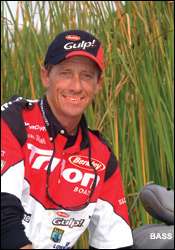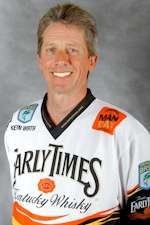
Spring sight fishing: perhaps nothing is more nerve racking than seeing a big bass hovering over a bed with a perfectly pitched soft bait lying inches away. Polarized sunglasses help see through the glare and optimum sunlight provides great color contrast. Hopefully, a cooperative mama bass will find the bait irritating and threatening enough to pick it up and move it.
But what if the water is murky or stained? Maybe the wind has a chop on the surface or perhaps the grass or brush blocks the view. I simply won't let these hurdles stand between me and some great "sight" fishing.
Whether I can see into the water or not I know I have to figure where the bass will be and find a pattern of how the fish are acting. I have to visualize what is happening below the surface, how the fish might be acting, what my bait presentation looks like and the influence of cover. Plus, I have to be aware of my boat positioning to keep off the spot and not blow water across the area with my trolling motor. Once I know the pattern I will place my boat in the best location for the bait presentation.
Vegetation is the key. Bushes, grasses and such will hold these bedding fish so I know where to look even if the water is stained or murky. This cover may provide a very insignificant clue to the pattern. For example, a vast field of spiderdot typically indicates a soft bottom but I know the stems will form a secure base, hard enough to hold a bed. Bass also will make a bed at the base of a button-bush or a willow tree. I simply dissect the apparent cover looking for anything that catches my eye. For example, if I have a large area of the same plant but in one area the plants appear taller, then I figure the bottom is a bit shallower there. If it's a grove of willows, I look for the single tree or one on a corner. But I have to establish a pattern as the best spot might be the second isolated tree from the edge. But I've still narrowed by search area by understanding the cover.
Docks will also hold bedding fish. Obviously I can't see the bottom but bass will bed at the base of the poles. It could be that when the dock was built a concrete slab was left and this provides a solid bedding location.
I use Berkley® Gulp!® baits for the fan cast presentations and slow retrieves required with these techniques. The scent dispersion sure gets the fish's attention and gives me more bites. For shallow water I'll use a 4 or 5-inch Sinking Minnow, a 5 or 7-inch Shaky Worm or a 5-inch Wacky Crawler on a 4/0 hook with a 3/16-ounce weight. If the water is deeper, I switch to the Gulp! Lizard or a Berkley Power® Craw with a ¼-ounce weight. Berkley Vanish®, in 17 or 20-pound test, gives me the strength and abrasion resistance I want plus this fluorocarbon is not stiff, giving me the bait presentation I desire.
My casts will be past the bedding area and I will slowly work the bait through moving it an inch at a time. Generally I am shaking the line causing the bait to quiver instead of move. If something feels different then I've found the sweet spot. I cast back in the exact same location with the same angle of retrieve. The bass is blowing the bait off the bed and not biting so more casts increase the fish's aggression. I might make as many as 30 pitches before enticing the bite.
Sometimes these bed-fishing conditions allow the bass to be less spooky and more aggressive. The 2006 Bassmaster Classic on Florida's Lake Toho was just like this. Berkley pro Luke Clausen won the event fishing grass beds in the same area I was fishing using these techniques. Luke's first day catch of nearly 30 pounds was just too much to catch and I finished fifth on the same pattern.
Deep-water bedding fish can be extremely tough. The fish are certainly not visible from the boat. But just like with shallow murky conditions, I have to use my head and find a pattern. Our tournament stops on Lake Rayburn in east Texas is typically during the spawn. But one year the rain raised the lake so high so quick that the beds were under 15 feet of water. I found bald spots in the pepper grass as this indicated a sandy bottom. The area was surrounded by hydrilla. Using a Carolina-rigged Power® Lizard, I drag the lizard parallel to the inside grass line. I don't set the hook if I feel something but simply let the bait sit. I then wait and watch the line. If it starts to move or I feel a mushy line I set the hook.
Fishing for bedding bass in murky water can be very interesting. But your mind has to be focused and very perceptive. Boat position and presentation are critical. But the fish are less spooky in these conditions, a definite advantage to sight fishing when you can't see the fish.





